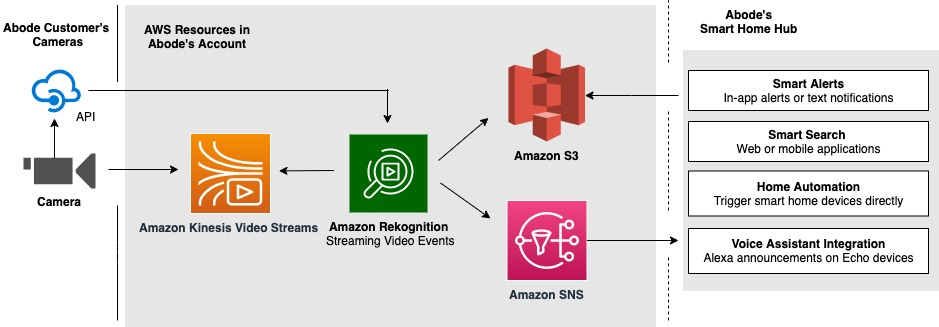Abode Systems (Abode) offers homeowners a comprehensive suite of do-it-yourself home security solutions that can be set up in minutes and enables homeowners to keep their family and property safe. Since the company’s launch in 2015, in-camera motion detection sensors have played an essential part in Abode’s solution, enabling customers to receive notifications and monitor their homes from anywhere. The challenge with in-camera-based motion detection is that a large percentage (up to 90%) of notifications are triggered from insignificant events like wind, rain, or passing cars. Abode wanted to overcome this challenge and provide their customers with highly accurate smart notifications.
Abode has been an AWS user since 2015, taking advantage of multiple AWS services for storage, compute, database, IoT, and video streaming for its solutions. Abode reached out to AWS to understand how they could use AWS computer vision services to build smart notifications into their home security solution for their customers. After evaluating their options, Abode chose to use Amazon Rekognition Streaming Video Events, a low-cost, low-latency, fully managed AI service that can detect objects such as people, pets, and packages in real time on video streams from connected cameras.
“We are always focused on making technology choices that provide value to our customers and enable rapid growth while keeping costs low. With Amazon Rekognition Streaming Video Events, we could launch person, pet, and package detection at a fraction of the cost of developing everything ourselves.”
– Scott Beck, Chief Technology Officer at Abode Systems.
Smart notifications for the connected home market segment
Abode recognized that to offer its customers the best video stream smart notification experience, they needed highly accurate yet inexpensive and scalable streaming computer vision solutions that can detect objects and events of interest in real time. After weighing alternatives, Abode leaned on their relationship with AWS to pilot Amazon Rekognition Streaming Video Events. Within a matter of weeks, Abode was able to deploy a serverless, well-architected solution integrating tens of thousands of cameras.
“Every time a camera detects motion, we stream video to Amazon Kinesis Video Streams and trigger Amazon Rekognition Streaming Video Events APIs to detect if there truly was a person, pet, or package in the stream,” Beck says. “Our smart home customers are notified in real time when Amazon Rekognition detects an object or activity of interest. This helps us filter out the noise and focus on what’s important to our customers – quality notifications.”
Amazon Rekognition Streaming Video Events
Amazon Rekognition Streaming Video Events detects objects and events in video streams and returns the labels detected, bounding box coordinates, zoomed-in images of the object detected, and timestamps. With this service, companies like Abode can deliver timely and actionable smart notifications only when a desired label such as a person, pet, or package is detected in the video frame. For more information, refer to the Amazon Rekognition Streaming Video Events Developer Guide.
“For us it was a no-brainer, we didn’t want to create and maintain a custom computer vision service,” Beck says. “We turned to the experts on the Amazon Rekognition team. Amazon Rekognition Streaming Video Events APIs are accurate, scalable, and easy to incorporate into our systems. The integration powers our smart notification features, so instead of a customer receiving 100 notifications a day, every time the motion sensor is triggered, they receive just two or three smart notifications when there is an event of interest present in the video stream.”
Solution overview
Abode’s goal was to improve accuracy and usefulness of camera-based motion detection notifications to their customers by providing highly accurate label detection using their existing camera technology. This meant that Abode’s customers wouldn’t have to buy additional hardware to take advantage of new features, and Abode wouldn’t have to develop and maintain a bespoke solution. The following diagram illustrates Abode’s integration with Amazon Rekognition Streaming Video Events.
The solution consists of the following steps:
- Integrate Amazon Kinesis Video Streams with Amazon Rekognition – Abode was already using Amazon Kinesis Video Streams to easily stream live video from devices such as video doorbells and indoor and outdoor cameras to AWS. They simply integrated Kinesis Video Streams with Amazon Rekognition to facilitate live video stream analysis.
- Specify video duration – With Amazon Rekognition, Abode can control how much video needs to be processed per motion event. Amazon Rekognition allows you to specify the length of the video clips to be between 0–120 seconds (the default is 10 seconds) per motion event. When motion is detected, Amazon Rekognition starts analyzing video from the relevant Kinesis video stream for the specific duration. This allows Abode the flexibility to better manage their machine learning (ML) inference costs.
- Choose relevant labels – With Amazon Rekognition, customers like Abode can choose one or more labels for detection in live video streams. This minimizes false alerts from camera motion events by sending notifications only when desired objects are detected in the video frame. Abode opted for person, pet, and package detection.
- Let Amazon Rekognition know where to send the notifications – When Amazon Rekognition starts processing the video stream, it sends a notification as soon a desired object is detected to the Amazon Simple Notification Service (Amazon SNS) destination configured by Abode. This notification includes the object detected, the bounding box, the timestamp, and a link to Abode’s specified Amazon Simple Storage Service (Amazon S3) bucket with the zoomed-in image of the object detected. Abode then uses this information to send relevant smart alerts to the homeowner, such as “A package has been detected at 12:53pm” or “A pet detected in the backyard.”
- Send motion detection trigger notifications – Whenever the smart camera detects motion, Abode sends a trigger to Amazon Rekognition to start processing the video streams. Amazon Rekognition processes the applicable Kinesis video stream for the specific objects and the duration defined. When the desired object is detected, Amazon Rekognition sends a notification to Abode’s private SNS topic.
- Integrate with Alexa or other voice assistants (optional) – Abode also integrated these notifications with Alexa Smart Home skills to enable Alexa announcements for their users. Whenever they receive a notification from Amazon Rekognition Streaming Video Events, Abode sends these notifications to Alexa to provide audio announcements from Echo devices, such as “Package detected at the front door.”
Conclusion
The connected home security market segment is dynamic and evolving, driven by consumers’ increased need for security, convenience, and entertainment. AWS customers like Abode are innovating and adding new ML capabilities to their smart home security solutions for their consumers. The proliferation of camera and streaming video technology is just beginning, and managed computer vision services like Amazon Rekognition Streaming Video Events is paving the way for new smart video streaming capabilities in the home automation market.
To learn more, check out Amazon Rekognition Streaming Video Events and developer guide.
About the Authors
 Mike Ames is a Principal Applied AI/ML Solutions Architect with AWS. He helps companies use machine learning and AI services to combat fraud, waste, and abuse. In his spare time, you can find him mountain biking, kickboxing, or playing Frisbee with his dog Max.
Mike Ames is a Principal Applied AI/ML Solutions Architect with AWS. He helps companies use machine learning and AI services to combat fraud, waste, and abuse. In his spare time, you can find him mountain biking, kickboxing, or playing Frisbee with his dog Max.
 Prathyusha Cheruku is a Principal Product Manager for AI/ML Computer Vision at AWS. She focuses on building powerful, easy-to-use, no-code/low-code deep learning-based image and video analysis services for AWS customers. Outside of work, she has a passion for music, karaoke, painting, and traveling.
Prathyusha Cheruku is a Principal Product Manager for AI/ML Computer Vision at AWS. She focuses on building powerful, easy-to-use, no-code/low-code deep learning-based image and video analysis services for AWS customers. Outside of work, she has a passion for music, karaoke, painting, and traveling.
 David Robo is a Principal WW GTM Specialist for AI/ML Computer Vision at Amazon Web Services. In this role, David works with customers and partners throughout the world who are building innovative video-based devices, products, and services. Outside of work, David has a passion for the outdoors and carving lines on waves and snow.
David Robo is a Principal WW GTM Specialist for AI/ML Computer Vision at Amazon Web Services. In this role, David works with customers and partners throughout the world who are building innovative video-based devices, products, and services. Outside of work, David has a passion for the outdoors and carving lines on waves and snow.

